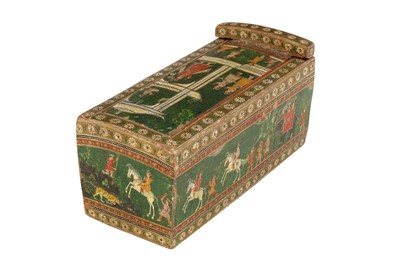28th Apr, 2023 14:00
Islamic & Indian Art
A SET OF POLYCHROME-PAINTED AND LACQUERED NINETY-TWO GANJIFA PLAYING CARDS WITH LIDDED BOX
Possibly Maharashtra, Central - Western India, mid to late 19th century
A SET OF POLYCHROME-PAINTED AND LACQUERED NINETY-TWO GANJIFA PLAYING CARDS WITH LIDDED BOX
Possibly Maharashtra, Central - Western India, mid to late 19th century
Comprising ninety-two polychrome-painted, gilt and lacquered playing cards (ganjifa), each of rounded shape, illustrated with a variety of Indian subjects including enthroned Maharajas and Maharanis, banqueting scenes and large celebrations, animals like camels, and dancers, set against alternating red, yellow, green and blue grounds, the reverse with a chequered grid with clusters of red dots filling the squares, each token 4.5cm diam.; and a rectangular box with sliding lid, polychrome-painted, heightened with gold and lacquered, featuring courtly processions and hunting scenes on the sides, and a courtly interior scene with a crowned princess or queen standing in a white pavilion, in conversation with two male attendants, sprays of white flowers decorating the outer borders and edges of the box, 17.5cm x 7.5cm x 8cm.
This type of hand-painted playing cards (ganjifa) is commonly in use in various South Asian territories like India, Pakistan, as well as Iran and Turkey. The game first reached India from Iran in the early 16th century. At the time, the eight-suited Mughal ganjifa pack became widespread. It was then later replaced by the Dashavatara ganjifa set, in which each suit represents one of Vishnu's avatars. A complete example of ganjifa pack can be seen in the Ashmolean Museum Collection, Oxford (inv. no. EAX.2078).
Sold for £5,500
Includes Buyer's Premium
Do you have an item similar to the item above? If so please click the link below to submit a free online valuation request through our website.








